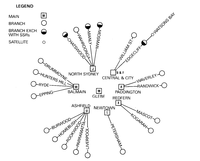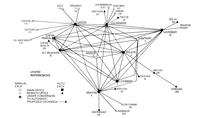


Chapter 8
I Part 1: Communications
i Before the Telegraph
ii Electrical Communication Before Federation
iii Federation to the End of the Second World War
iv Post-war and on to 1975
v 1975 ONWARDS
II Epilogue
III Part 2: Early Australian Computers And Computing
IV Acknowledgements
References
Index
Search
Help
Contact us

Federation to the End of the Second World War (continued)
In large networks it was necessary to plan for a long period during which a part, often a major part, of the network would remain manual, inter-working with the new automatic exchange or exchanges. Sydney, for instance, had 26 exchanges and a five digit main/branch configuration was adopted, with initial planning providing for nineteen automatic exchanges in three stages, but wartime financial problems caused the third stage to be abandoned and only eleven were actually provided. Because the largest manual exchanges were almost new, some of the main exchanges were established in temporary locations and in due course replaced at their planned locations. By 1920 the network had stabilised to the form it was to remain until 1938.[16]
Initially all manual numbers were switched via City on level 2 but by late 1915, access codes for all manual exchanges except Liverpool were introduced. Sydney may have been the first city in the world to use the automatic network as a 'mechanical tandem' to switch traffic between manual exchanges that were not connected by direct junction routes. Subsequent development of the Sydney network followed the plan which had been established, included the introduction of six digit numbering, exchange by exchange as necessary, with manual exchanges converted as they reached capacity or the end of their economic service life. In 1925 and 1926, in order to allow subscribers on automatic exchanges to dial subscribers in North, Edgecliff and Kogarah, automatic terminating equipment was installed in these exchanges but unfortunately no record has been located of the special design of the final selectors.
No doubt influenced by the growth in cable networks as exchange areas increased and transmission problems developed, a review of exchange layouts was undertaken in the mid nineteen thirties. The plan which resulted involved a total of 77 exchanges, an arrangement which was beyond the capacity of a six digit main/branch exchange scheme. A limited use of satellite exchanges (1000 line groups detached from a branch exchange) enabled this problem to be overcome in the short term, but the basic problem of the Sydney numbering scheme remained until seven digit numbering was introduced in the nineteen sixties.
The upgrading of manual installations in Melbourne, referred to earlier, had the result that by 1914, 85 per cent of Melbourne subscribers were connected to exchanges that were less than four years old and therefore the scope for automatic was limited initially. Brighton was converted in 1914, followed by Sandringham in 1918 and Malvern in about 1919. A numbering scheme for Melbourne was planned in 1921 with mixed five and six digits, but only three more automatic exchanges were established by 1925. After this slow start, more rapid progress was made and by 1939, over 75 per cent of lines were automatic. Various forms of the problems encountered in Sydney were experienced in Melbourne also and met by rather similar network methods.

 |
Australian Academy of Technological Sciences and Engineering |  |
© 1988 Print Edition pages 549 - 550, Online Edition 2000
Published by Australian Science and Technology Heritage Centre, using the Web Academic Resource Publisher
http://www.austehc.unimelb.edu.au/tia/538.html